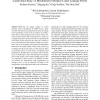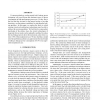115
Voted
CAL
2002
15 years 17 days ago
2002
Abstract-This paper proposes the use of four-transistor (4T) cache and branch predictor array cell designs to address increasing worries regarding leakage power dissipation. While ...
103
Voted
TVLSI
2008
15 years 18 days ago
2008
-- Aggressive CMOS scaling results in low threshold voltage and thin oxide thickness for transistors manufactured in deep submicron regime. As a result, reducing the subthreshold a...
112
Voted
PACS
2000
Springer
15 years 4 months ago
2000
Springer
Reducing the supply voltage to reduce dynamic power consumption in CMOS devices, inadvertently will lead to an exponential increase in leakage power dissipation. In this work we ex...
91
Voted
ISLPED
2005
ACM
15 years 6 months ago
2005
ACM
As FPGAs enter the nanometer regime, several modifications are needed to reduce the increasing leakage power dissipation. Hence, this work presents some modifications to the FPG...
104
Voted
ISCAS
2008
IEEE
15 years 7 months ago
2008
IEEE
Abstract— This paper presents circuits that enable dynamic voltage and frequency scaling (DVFS) for finegrained chip multi-processors to reduce both dynamic and leakage power di...
CODES
2008
IEEE
15 years 7 months ago
2008
IEEE
Adaptive Body Biasing (ABB) is a popularly used technique to mitigate the increasing impact of manufacturing process variations on leakage power dissipation. The efficacy of the ...
123
click to vote
ICCD
2006
IEEE
15 years 9 months ago
2006
IEEE
— Leakage power dissipation becomes a dominant component in operation power in nanometer devices. This paper describes a design methodology to implement runtime power gating in a...
108
Voted
HPCA
2005
IEEE
16 years 1 months ago
2005
IEEE
If current technology scaling trends hold, leakage power dissipation will soon become the dominant source of power consumption in high performance processors. Caches, due to the f...
98
Voted
VLSID
2009
IEEE
16 years 1 months ago
2009
IEEE
Abstract-- Single-ended static random access memory (SESRAM) is well known for their tremendous potential of low active power and leakage dissipations. In this paper, we present a ...


